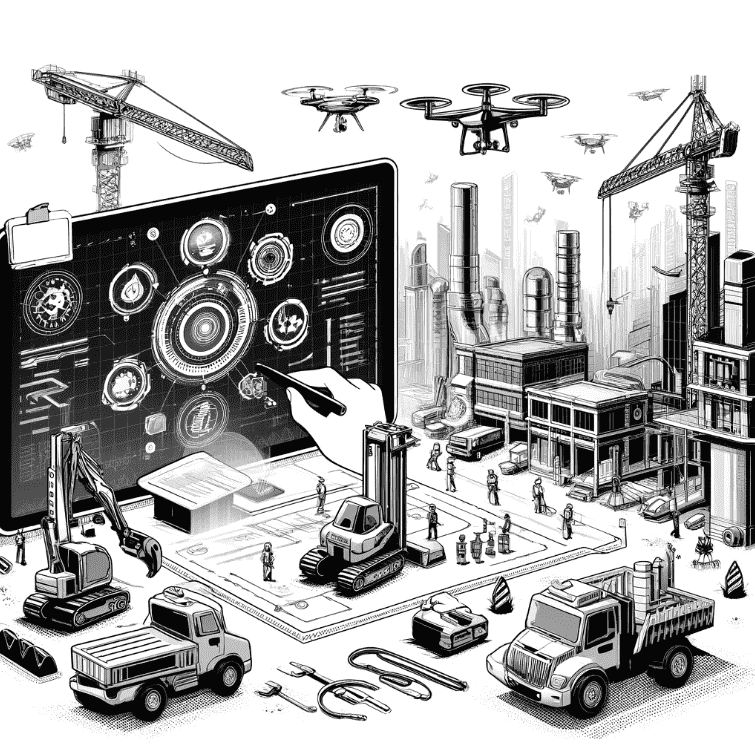Definition of Construction Technology
The construction realm is filled with new superheroes, but not the ones with capes and secret identities. These superheroes are clad in digital armor, carrying an arsenal of innovative tools and techniques known as construction technology. This dynamic, ever-evolving entity offers a whole new paradigm of efficiency, productivity, and safety for the industry.
Be it 3D printing, Building Information Modeling (BIM), automated equipment, or the latest wearable tech devices; each element is more than a shiny novelty. They are purpose-built allies, streamlining project management and tackling industry challenges, like labor shortages and complex tasks, with an effortless finesse that only technology can offer.
Benefits of Utilizing Construction Technology
Here’s where the charm of construction technology really shines for construction companies; the tantalizing promise of revolution. With construction technology leading the vanguard, project management is no longer a daunting task but a walk in the park, thanks to the myriad of software and tools available. The enhanced communication and collaboration among stakeholders are the keys to efficient, successful projects.
Moreover, efficiency is redefined with robots and 3D printers at the helm, delivering faster, more precise construction projects. The cost savings are where the spotlight lingers – with these innovative tools and processes, construction professionals become wizards of resource allocation and warriors against waste. Digital is the new norm, and with its entrance, we bid farewell to the days of printed blueprints and their associated costs.
Types of Construction Technology
Just when you thought you’ve seen it all, let’s explore the various flavors of construction technology. First, we have modular construction, the real-life embodiment of giant Lego blocks, offering reduced construction time, improved quality control, and minimized waste.
Then comes 3D printing, making waves in the construction industry by enabling the creation of complex, customized structures, significantly reducing both construction time and costs.
Meanwhile, high-tech wearables gather real-time data about worker safety and productivity, enhancing both safety and efficiency on the construction site by integrating 3D Model technology.
From construction robots that could give WALL-E a run for his money, to virtual reality tools that make building inspections feel like a video game, and even digital ledger systems, the list of tech advances reshaping the construction industry is endless.

3D Printing
3D printing, a game-changer in the world of construction technology, has revolutionized traditional building approaches. It eliminates the complexities of material sourcing and significantly reduces waste by providing accurate measurements using digital models.
However, as with any superhero, there are a few kryptonite-like limitations. The size and scale of 3D printers and the time required to print larger structures can slow down efficiency. But fear not, as technological advances continue, these limitations will soon become minor speed bumps on the path to innovation.
Building Information Modeling (BIM)
Building Information Modeling, or BIM, is the digital genie granting construction professionals the power to visualize and simulate the entire construction process. It’s a fantastic error-buster and a communication enhancer, paving the way for smoother collaboration and more efficient project workflows. The tool’s knack for generating detailed cost estimates helps keep projects on budget for project managers during the construction phase.
Modular Construction
Modular construction is another innovator in the construction world. It’s a method that combines construction and tech in a beautiful union. The technique promotes waste reduction, lowers emissions, and leverages machine learning for optimization, resulting in timely project delivery.
We are sure to see more construction business unfold with this type of building methods as we head into the near future
Semi-Automated and Automated Construction Equipment
Semi-automated and automated equipment are driving another technological revolution in the construction industry. These machines employ sensors, drones, and GPS navigation systems to execute tasks with incredible precision, saving time and reducing the scope for human error. The day to day of Construction managers has the potential to radically change in the next 5 to 10 years, managing robots instead of just humans.
Moreover, they contribute significantly to a safer and more balanced work environment.
Wearables and Robotics
The impact of construction wearables and robotics on the construction industry is impressive. From sensor-embedded Personal Protective Equipment (PPE) to advanced robotics, these technologies provide critical data for safety risk prediction and accident prevention. They also enhance on-site communication and collaboration, promoting coordination, efficiency, and risk reduction.
Furthermore, robots can handle repetitive and hazardous tasks, freeing human workers to focus on complex, high-value activities.

Impact on the Construction Industry
As dawn breaks, digital technology and construction have intertwined in a fascinating dance of evolution. These once separate spheres now harmonize, streamlining processes, propelling efficiency, fortifying safety measures, and breaking down cost barriers. Like skilled artists, tools like Building Information Modeling (BIM), 3D printing, virtual reality, and digital ledgers are painting a fresh image of construction, enhancing collaboration, shrinking errors, and enabling meticulous planning.
Labor Shortage Solutions
A relentless labor shortage lingers over the construction sector, with an aging workforce and a dwindling population of skilled workers. Yet, as a rising phoenix, technology-based solutions emerge, shedding light on new opportunities to resolve this issue and captivate a younger demographic. By automating tasks traditionally done by laborers and introducing engaging, tech-savvy tools, the industry may not only mitigate labor shortages but also create an enticing environment for the new generation, all the while increasing construction productivity.
Improved Project Management
In the realm of project management, technology emerges as a knight, defending efficiency, enhancing connectivity, and presenting valuable data insights. Construction tech tools and software promote seamless interaction between the field and the office, driving informed decision-making, prompt problem-solving, and reducing delays. In essence, technology offers a roadmap to success, simplifying project planning, organization, scheduling, and management.
More Complex Projects
The collaboration between technology and construction has unfurled a realm where complexity marries feasibility. Digital tools like BIM, 3D printing, and automated equipment are the new architects of innovation, enabling detailed digital representations of buildings, creation of intricate structures, and precision in execution. The result is a dramatic evolution in design and construction processes, pushing the industry towards the execution of increasingly complex projects.
Increased Efficiency in the Construction Process
The rhythm of the building processes have quickened with technology orchestrating a symphony of efficiency. Through digital tools like BIM and automated equipment, tasks that once were labor-intensive and time-consuming now unfold with remarkable speed and accuracy. In the grand scheme, this technological integration catalyzes a ripple effect, enhancing project management, improving resource allocation, and enabling the realization of ambitious, well-rounded structures.
And as we all know with increased efficiencies, project costs are slashed.

Role of Professionals in the Adoption of Technology
As we delve deeper into the symphony of digital transformation, it becomes clear that construction industry professionals don’t merely serve as conductors; they are the composers, crafting the harmony of innovation and tradition. Their role in leading the adoption of technology is absolutely instrumental. They chart the industry’s path forward, steering it through the tides of change towards shores of enhanced efficiency and productivity.
Champions of technology in the industry, these professionals shoulder the responsibility of breaking new ground. Without their proactive advocacy and fervent exploration of emerging tools, the potential for technological stagnation looms large. Just as the symphony cannot progress without the composer’s next note, construction tech integration can stall in the absence of dedicated, forward-thinking professionals.
A proactive approach is not merely beneficial, but essential for these champions. As technology advances at breakneck speed, industry professionals who do not actively adopt and adapt run the risk of being left in the dust of obsolescence. In order to be proactive, however, professionals must have a comprehensive understanding of the rapidly evolving tech landscape. Their approach to embracing new tools must involve ongoing education, diligent research, and the cultivation of a mindset that sees change not as a threat, but as an opportunity.
That being said, the adoption of technology is not a rush towards the shiny and new, but a calculated evolution that values due diligence. Professionals are tasked with meticulously assessing the potential of each tool, understanding its benefits, limitations, and the potential impact on their work. This process is a delicate balancing act – one that aims to integrate beneficial innovations without disrupting proven practices and systems.
In the final analysis, construction industry professionals are the vanguard of the industry’s future. They pioneer new paths, leveraging their understanding and skills to ensure the industry doesn’t just survive, but thrives in a future shaped by digital innovation. Their diligence, proactive nature, and penchant for pushing boundaries serve as the backbone of the industry’s continuous evolution. With every tool they adopt and implement, these champions write another bar in the symphony of construction technology, echoing with the promise of increased productivity, efficiency, and success.
